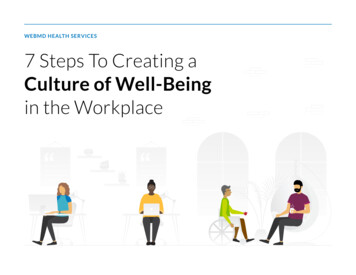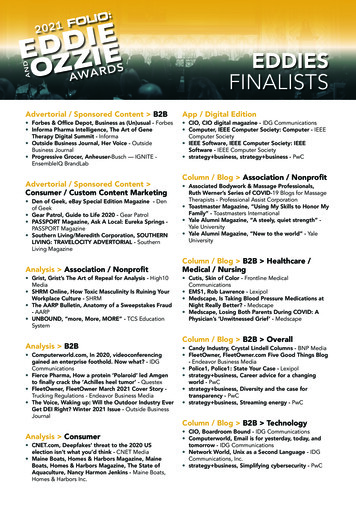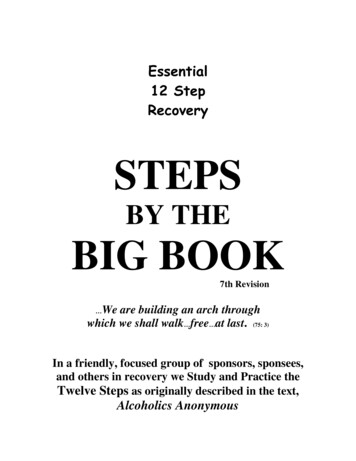
Transcription
WEBMD HEALTH SERVICES7 Steps To Creating aCulture of Well-Beingin the Workplace
Table of Contents7 Steps To Creating a Culture of Well-Being in the Workplace . 3So, what is workplace culture?. 4Why does a well-being culture matter?. 4Step 1: Identify Your Vision . 5Step 2: Consider Your People . 6Step 3: Get Feedback . 7Step 4: Outline Your Well-Being Culture. 9Step 5: Create a Strategy. 10Step 6: Implement Your Ideas. 11Step 7: Measure Your Success. 12Lead By Example . 13
7 Steps To Creating aCulture of Well-Beingin the WorkplaceCulture in the workplace. What does this really mean? There areso many discussions around great company cultures these days,yet many organizations struggle to define what culture looks likefor their own companies. WebMD Health Services Group, Inc. webmdhealthservices.com7 Steps To Creating a Culture of Well-Being in the Workplace 3
So, what is workplace culture?Why does a well-being culture matter?Culture drives a company’s expectations and energy. It defines howA company’s culture is a vital competitive advantage that helps tothings are created, how people collaborate, and how business decisionsrecruit and retain top talent. Many even view culture as a measure ofare made.overall business success and align it to the bottom line financial worthof a company.Culture is developed after a company’s mission statement and values aredefined. All these elements act as guiding lights to how you hire, conductAnd the well-being of each employee contributes to the collectiveperformance reviews, discover business opportunities, support yourwell-being and culture of your organization. Therefore, an environmentpopulations, and so much more—because they’re aligned with who youthat supports employee well-being is essential to creating a culture thatare as an organization.can work for your organization.How can you create and nourish a culture of well-being at yourPlus, there’s a strong, positive correlation between well-being,organization? It takes a clear vision and a thoughtful approach—notproductivity, and organizational performance.1 And today, employeejust from the top down, but also from the inside out.well-being is a business priority for most organizations—73% say theywill make health culture a top priority over the next three years.2 ThisThis e-book explains how to bring a culture to life at your company.was before the pandemic thrust employee well-being into the spotlight,so current numbers are likely to be even higher.To sum it up, a well-being culture matters because it helps supportboth your people and your company overall. But it must be donecorrectly—and align with your values—to be successful.Here are the seven steps to creating a successful well-being cultureat your organization.12World Economic Forum. It’s official: happy employees mean healthy firms. July 18, 2019.Willis Towers Watson. 2019 Best Practices in Health Care Employer Survey Highlights. November 5, 2019.7 Steps To Creating a Culture of Well-Being in the Workplace 4
STEP 1Identify Your VisionBefore you do anything else, you must determine what you wantyour culture to look like. A culture of well-being must tie back toyour core values and beliefs and be the backdrop of everythingyou do—from the ways people lead the organization down tohow you treat employees and customers.Without these values to fall back on, touting a good workplace culture willfall flat. Show you care about well-being by emulating your workplacevalues at every business decision—from who you do business with to whatsnacks are offered in the breakroom to your flexible work model.For many companies, their workplace culture might currently feel differentthan how it was before the pandemic. So forget what your culture used to be,and focus on where your organization is right now. Then, ask yourself: Where do you want your organization to be in a year from now? What values do you want your company to live? What business opportunities should you seek? How do you want employees to talk to each other and work together? What purpose or meaning does your work provide? Where will employees spend most of their workday—at home, in anoffice, in the field, or a combination? What type of programs and resources are needed to bettersupport your employees?Once you’ve answered these questions, you’ll have clear, current values.From there, you can strategize ways to develop a well-being culture thataligns with your answers. WebMD Health Services Group, Inc. webmdhealthservices.com7 Steps To Creating a Culture of Well-Being in the Workplace 5
STEP 2Consider Your PeopleYou want and expect your employees to work hard, sure—butit’s also important for them to feel like you have their backs,even outside the workplace. Bring their passions, interestsand personal lives into the mix so people can learn from eachother and create a stronger connection.For this step, it’s critical to encourage authenticity. Leaders must figure out howto allow people to integrate their authentic selves into the workplace. Thismight sound difficult, but it doesn’t have to be. It’s as simple as making peoplefeel comfortable enough to open up about shared experiences, challenges, joys,and interests to develop a deeper bond.How can you make your populations feel seen and heard? Here aresome suggestions: Allow people to discuss their volunteerism efforts during meetings. Vote on the organizations you can donate to or volunteer for asa company. Make time in team meetings to discuss personal interests or hobbies. Start message groups about movies, shows, music, and other thingsto encourage discussions outside of work-related topics. Create space in one-on-one meetings to ask people how they’redoing, and if they need any support. WebMD Health Services Group, Inc. webmdhealthservices.com7 Steps To Creating a Culture of Well-Being in the Workplace 6
STEP 3Get FeedbackIt’s important to include perspectives from several differentroles and departments—including both in-person and remoteemployees. That way, everyone in your employee base will beaccounted for in strategic discussions—and your positive culturecan really work to support everyone. Include your leadershipteam, too, because they’ll need to bring this well-being cultureto life throughout the entire organization.Have an open discussion about the needs and expectations of your population.What do you hear most? If they need support for mental health, for example,then look into the different ways you can help—increasing PTO for mentalhealth days, expanding your EAP program, offering health coaching, providingstress and resiliency training, offering more flexible work schedules, and more.Write down all ideas and suggestions. From there, you’ll have a solid list ofactionable ways to better support your people and create a positive culturethat they’d be glad to contribute to. After all, if you make your people happy,you may even increase retention and productivity. WebMD Health Services Group, Inc. webmdhealthservices.com7 Steps To Creating a Culture of Well-Being in the Workplace 7
Looking for suggestions?Our clients send out surveys to discover how they can better support their people.Here are some solutions they recently added to improve their culture of well-being: Mental health podcasts Client-specific well-being webinars Flexible work schedules Hybrid work models Extra PTO for mental health days Financial wellness programs Virtual activities to improve social connectedness Community volunteering opportunities Culture committees Social justice wellness challenges7 Steps To Creating a Culture of Well-Being in the Workplace 8
STEP 4Outline YourWell-Being CultureAfter you’ve outlined your organization’s current values andgathered feedback, it’s time to document what you want yourculture to look like. Consider everything from wellness breaksto offering healthy lunches. Make sure you get leadershipbuy-in here, because without their participation, the cultureyou envision may not happen. No-meeting Fridays Hybrid work models tailored to each employee’s situation Flex schedules Paid time off for mental health days, volunteering and doctor visits Company-paid healthy lunches once a month Walking meetings Mental health lunch and learns Well-being and mental health trainings for managers Health fairs Incorporating well-being topics in town halls Breaks for physical fitness, meditation or other wellness activity WebMD Health Services Group, Inc. webmdhealthservices.com7 Steps To Creating a Culture of Well-Being in the Workplace 9
STEP 5Create a StrategyOnce you’ve determined the elements you want to add to yourorganization, make a plan for rolling it out. Your strategy should include:Actionable, measurable steps.Metrics to consider.A review process.Every point must be concrete to avoidYour culture can be measured in some ways.Investing in developing a culture can be hardsubjective interpretation. For example,Consider the ways you’d want to measurework—especially if you’re trying to move in a“promote well-being” is not an actionableyour culture, such as:different direction—so you want to make sureor measurable step, but “launch awell-being program in January” is. Employee surveys and check-ins Benefits enrollments and usage reportsDecide which elements you want to Well-being program engagement metricsimplement when, and be mindful not to In-person and virtual attendance forlaunch everything at once. Remember, ittakes time to evolve and enhance a workplaceculture. Releasing certain aspects overtime will make the transition a bit easierfor everyone—employees included. WebMD Health Services Group, Inc. webmdhealthservices.comevents and activitiesyour investment is being used wisely. Establishparameters to measure progress, including whenand how you’ll collect metrics.During reviews, you can also identify any areas toenhance, evolve, update, or remove to constantlyimprove the culture at your organization. Productivity metricsOnce you’ve outlined a strategy, you’reready to implement your ideas to enhanceyour culture!7 Steps To Creating a Culture of Well-Being in the Workplace 10
STEP 6Implement Your IdeasYou’ve figured out where you want your culture to be and howyou’re going to get there. Now it’s time to see your ideas in action.As you launch certain aspects of your new culture—such as buildingculture committees or adding a new element to your well-beingprogram—make sure your employees know about them! Send regularHere are some ideas to involve leadership in your well-being culture: Have the CEO discuss well-being in town halls.communications to share current initiatives, why they’re important, and Ask leaders to block time on their calendars for fitness or meditation.how they can get involved. Invite people to company-sponsored virtual wellness meetings.Look for multiple opportunities to get the word out—including posters,discussions during company-wide meetings, and emails—to help youremployees not only benefit from your culture but contribute to it. Encourage leaders to be open about taking time off to care forthemselves—physically and mentally—like signing out of office emailswith “taking a mental health day to rest and recharge.” Advertise well-being activities coming up, highlight resources andAnd don’t forget about leadership. Everyone from the top down mustsupport and promote this new culture for it to truly be successful. Ifpeople don’t see their managers engaging in well-being, they won’t feelcomfortable making it a priority for themselves. WebMD Health Services Group, Inc. webmdhealthservices.comencourage people to take breaks. Host lunch and learns about well-being topics. Recognize and acknowledge positive contributions to the culture.7 Steps To Creating a Culture of Well-Being in the Workplace 11
STEP 7Measure Your SuccessOver time, you should start to notice your culture evolving. Is it becomingIt’s also a good idea to send out surveys that employees can answerwhat you wanted it to be, or has it shifted to become something else?anonymously. Get their feedback on what’s working, what’s not, and whatDo your employees feel supported? What about those who are workingthey want from you. Then, make sure to follow up so they know they’ve beenremotely? Look at your metrics to determine where you might want toheard. And when you do implement something new or update an existing partimprove or iterate your existing implementations to better assist yourof your culture because of feedback, let that be known—it’s a great way toemployees and overall company culture.encourage others to keep sharing their feedback. WebMD Health Services Group, Inc. webmdhealthservices.com7 Steps To Creating a Culture of Well-Being in the Workplace 12
Lead By ExampleUltimately, a successful workplace culture comes down to what leaders of the organizationdo—or don’t do—every day. Living what you want your employees and fellow leaders todo is one of the most essential parts of building a strong workplace culture. Whateveryou embrace as your culture, your employees will adopt.What might this look like? Managers may embrace your well-being culture by: going on a run at lunchtime. sending messages of appreciation and recognition to team members. working from home when they need to, and allowing others to do the same. encouraging flex schedules for doctor appointments or other well-being needs. signing up for a volunteer opportunity or company-sponsored wellness challenge.7 Steps To Creating a Culture of Well-Being in the Workplace 13
Every company is unique,making each culture different as wellAs you consider where to take your culture next, make sure your ideas align with yourcompany’s values first. Then, consider your employees’ interests, needs and expectations.Because if they’re happy, your business can truly thrive. WebMD Health Services Group, Inc. webmdhealthservices.com7 Steps To Creating a Culture of Well-Being in the Workplace 14
Empowering Well-Being In EveryoneReady to elevate your culture? Reach out to connect@webmd.net.webmdhealthservices.com
WebMD Health Services roup, Inc. webmdhealthservices.com 7 Steps To Creating a Culture of Well-Being in the Workplace 10 As you launch certain aspects of your new culture—such as building culture committees or adding a new element to your well-being










